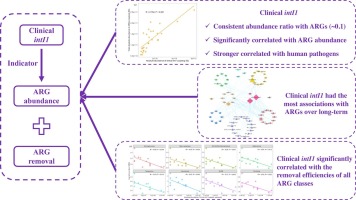当前位置:
X-MOL 学术
›
Environ. Int.
›
论文详情
Our official English website, www.x-mol.net, welcomes your
feedback! (Note: you will need to create a separate account there.)
Clinical class 1 integron-integrase gene - A promising indicator to monitor the abundance and elimination of antibiotic resistance genes in an urban wastewater treatment plant.
Environment International ( IF 10.3 ) Pub Date : 2019-12-12 , DOI: 10.1016/j.envint.2019.105372 Wanlin Zheng 1 , Jiaoqi Huyan 2 , Zhe Tian 2 , Yu Zhang 2 , Xianghua Wen 3
Environment International ( IF 10.3 ) Pub Date : 2019-12-12 , DOI: 10.1016/j.envint.2019.105372 Wanlin Zheng 1 , Jiaoqi Huyan 2 , Zhe Tian 2 , Yu Zhang 2 , Xianghua Wen 3
Affiliation

|
In this study, 295 antibiotic resistance genes (ARGs) and mobile genetic elements (MGEs) from the influent, activated sludge (AS), and membrane bioreactor (MBR) permeate were primarily examined in the wastewater treatment plant (WWTP) biweekly over 13 months. The absolute concentrations of ARGs and MGEs respectively ranged from 1.27 × 1010 to 1.94 × 1011 and 8.00 × 109 to 1.24 × 1011 copies/L in the influent, of which were reduced by 2 to 3 orders of magnitude in the permeate. No significant seasonal variation of ARGs and MGEs was found in the WWTP, except that the absolute abundance of ARGs and MGEs in the AS was peaked during spring. The antibiotics affected neither ARGs nor MGEs significantly, suggesting their concentrations may be not high enough to pose a selective pressure. In contrast, the bacterial community had direct effect on the MGEs variation, meanwhile the MGEs influenced the ARG abundance directly. Class 1 integron-integrase gene (intI1), clinical intI1, and Tn21 associated more frequently with ARGs in the AS over long-term, suggesting the potential of them involved in horizontal gene transfer. Both intI1 and clinical intI1 had significantly positive associations with the overall abundance of ARGs, as well as significantly negative relationships with the overall removal rates of ARGs in the MBR. However, the abundances between intI1 and clinical intI1 were significantly different. Meanwhile, clinical intI1 remained rather consistent proportion with the ARG abundance in the AS and permeate, was stronger correlated with human pathogens, and was associated with greater number of ARGs over time. Moreover, clinical intI1 was significantly associated with the removal efficiency of ARGs from all classes. Taken together, clinical intI1 can be adopted as an indicator for the abundance and removal efficiency of ARGs in the WWTP.
中文翻译:

1类临床整合素整合酶基因-一种有前途的指标,可用于监测城市污水处理厂中抗生素抗性基因的丰度和消除情况。
在这项研究中,来自污水,活性污泥(AS)和膜生物反应器(MBR)渗透液的295种抗生素抗性基因(ARGs)和流动遗传元素(MGEs)主要在废水处理厂(WWTP)中每两周检查一次,历时13个月。 。进水中ARG和MGE的绝对浓度分别为1.27×1010至1.94×1011和8.00×109至1.24×1011拷贝/ L,其中渗透物降低了2至3个数量级。在污水处理厂中没有发现ARG和MGE的明显季节性变化,只是AS的ARG和MGE的绝对丰度在春季达到峰值。抗生素对ARG和MGE均无明显影响,表明其浓度可能不足以产生选择性压力。相比之下,细菌群落对MGEs的变化有直接影响,而MGEs直接影响ARG的丰度。长期来看,Class 1整合子整合酶基因(intI1),临床intI1和Tn21与AS中的ARGs关联更频繁,这表明它们可能参与水平基因转移。intI1和临床intI1与ARG的总体丰富度呈显着正相关,与MBR中ARGs的整体去除率呈显着负相关。但是,intI1和临床intI1之间的丰度存在显着差异。同时,临床intl1与AS和渗透液中ARG的丰度保持相当一致的比例,与人类病原体的相关性更强,并且随着时间的推移与更大数量的ARG相关。而且,临床intI1与所有类别的ARGs的去除效率显着相关。综上所述,临床intI1可作为污水处理厂ARGs丰度和去除效率的指标。
更新日期:2019-12-13
中文翻译:

1类临床整合素整合酶基因-一种有前途的指标,可用于监测城市污水处理厂中抗生素抗性基因的丰度和消除情况。
在这项研究中,来自污水,活性污泥(AS)和膜生物反应器(MBR)渗透液的295种抗生素抗性基因(ARGs)和流动遗传元素(MGEs)主要在废水处理厂(WWTP)中每两周检查一次,历时13个月。 。进水中ARG和MGE的绝对浓度分别为1.27×1010至1.94×1011和8.00×109至1.24×1011拷贝/ L,其中渗透物降低了2至3个数量级。在污水处理厂中没有发现ARG和MGE的明显季节性变化,只是AS的ARG和MGE的绝对丰度在春季达到峰值。抗生素对ARG和MGE均无明显影响,表明其浓度可能不足以产生选择性压力。相比之下,细菌群落对MGEs的变化有直接影响,而MGEs直接影响ARG的丰度。长期来看,Class 1整合子整合酶基因(intI1),临床intI1和Tn21与AS中的ARGs关联更频繁,这表明它们可能参与水平基因转移。intI1和临床intI1与ARG的总体丰富度呈显着正相关,与MBR中ARGs的整体去除率呈显着负相关。但是,intI1和临床intI1之间的丰度存在显着差异。同时,临床intl1与AS和渗透液中ARG的丰度保持相当一致的比例,与人类病原体的相关性更强,并且随着时间的推移与更大数量的ARG相关。而且,临床intI1与所有类别的ARGs的去除效率显着相关。综上所述,临床intI1可作为污水处理厂ARGs丰度和去除效率的指标。











































 京公网安备 11010802027423号
京公网安备 11010802027423号